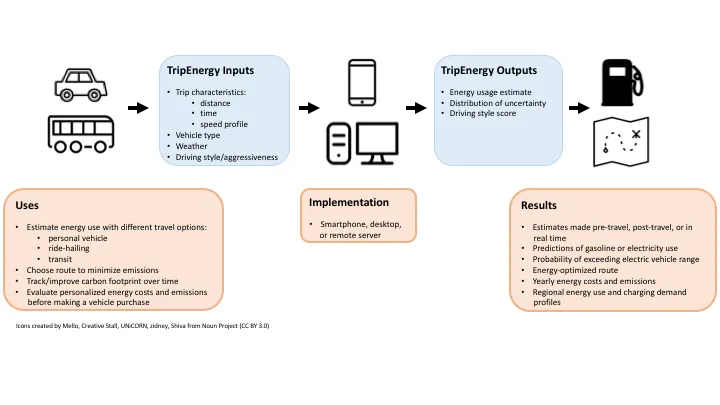TripEnergy
TripEnergy is a data processing methodology that turns incomplete information on vehicle travel into a predictive estimate of the energy requirements of travel. It is designed to work with personal vehicle trips, producing energy estimates given information such as trip distance and/or duration from a survey. It can also work with low-resolution vehicle trajectories reconstructed from historical traffic data or generated in a transport network simulation. The model is capable of estimating energy requirements for a large variety of internal combustion and battery electric vehicles and can be extended to apply to a wide variety of vehicle types including bus, heavy rail, and ridesharing.
Researchers
-
system and method for estimating and predicting vehicle trip energy consumption
United States of America | Granted | 11,346,678
Figures
Technology
TripEnergy uses a demand model and vehicle model to estimate personal vehicle energy consumption for which only limited information is available. The demand model takes limited-resolution input information on a trip's characteristics and matches it with a large set of possible high-resolution velocity histories arising from similar trips. This set of trips spans the range of driving conditions that could be associated with that trip through realistic use. If ambient temperature is not supplied as an input, the demand model also produces a set of possible ambient temperatures for that trip based on the location, time of day, and day of the year on which the trip was taken. This set of velocity histories and temperatures is fed into the vehicle model which converts them into a distribution of possible energy requirements of that trip. The vehicle model is extensively calibrated based on test data and validated through vehicle simulation software, accounting for tractive energy consumption, conversion efficiency, and climate control auxiliary use.
Additionally, TripEnergy has been integrated with a regional transport network simulation, allowing for travel behavior and energy consumption to be modeled on a large scale. These simulation methods evaluate a large number of possible choices for each of the hundreds of thousands of separate agents active on a transportation network at any one time. Such simulations allow agents to make decisions based on the costs associated with this choice set. The ability to estimate energy consumption in real time allows the simulation to provide more options to the choice sets of simulated users, including more realistic options such as driving in a less aggressive, more fuel-efficient way, choosing routes based on minimizing fuel costs, or purchasing a more fuel-efficient vehicle.
Problem Addressed
There is great value in an accurate prediction of a trip’s energy consumption, particularly if the prediction can be made for many trips in a population of drivers and vehicles. This is particularly true as electric vehicles become more common and regions work to limit air pollution and greenhouse gas emissions. Currently, trip energy consumption is often either estimated based simply on the vehicle's rated fuel economy and a trip's distance. Alternatively, these estimates are done through complex, black-box simulations that require detailed information on the trip characteristics which cannot be predicted in advance. These simulations are also slow to run and difficult to operate at scale for large datasets, in real time. TripEnergy combines the analytic rigor of simulation methods with ease of use and flexibility and is particularly geared towards predictive estimates of trips’ energy consumption across a population.
Advantages
- TripEnergy produces accurate estimates for the energy requirements of trips without requiring extensive additional data collection about the conditions of the trips or vehicle performance characteristics. Rather, it uses existing databases. The model has been shown to be accurate based on extensive validation. This unique capability is based on new insights on travel energy consumption behaviors.
- Because of its unmatched computational efficiency, TripEnergy can provide real-time feedback to users regarding the energy impacts of their choices.
- Realistic energy use predictions will allow drivers, apps, and policy makers to choose or incentivize travel choices that maximize energy efficiency and minimize pollution. This is in contrast to imperfect proxies such as total travel time or total vehicle miles traveled.
- The functionality can extend beyond vehicular energy consumption to monitor other sources of energy consumption in daily life. For example, it allows users to track the carbon impact of their lifestyle choices in real time and predictively evaluate the energy and pollution effects of buying a new vehicle, moving to a new household, and installing residential solar panels. The model provides a unique degree of accuracy that allows the impact of such sources to be reliably quantified.
License this technology
Interested in this technology? Connect with our experienced licensing team to initiate the process.
Sign up for technology updates
Sign up now to receive the latest updates on cutting-edge technologies and innovations.
